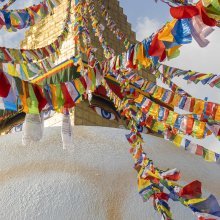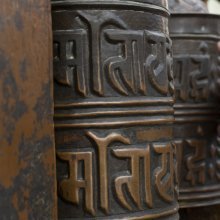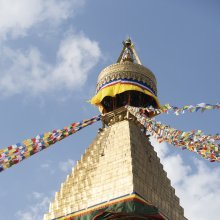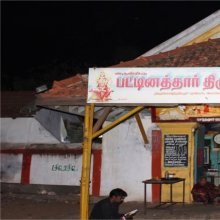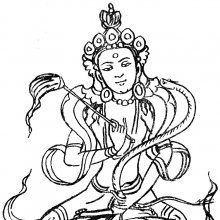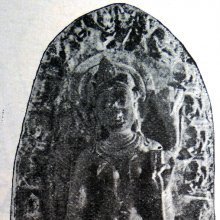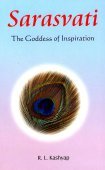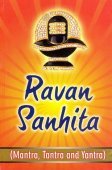Mantra, Māntra, Mamtra: 56 definitions
Introduction:
Mantra means something in Buddhism, Pali, Hinduism, Sanskrit, Jainism, Prakrit, the history of ancient India, Marathi, Hindi. If you want to know the exact meaning, history, etymology or English translation of this term then check out the descriptions on this page. Add your comment or reference to a book if you want to contribute to this summary article.
Images (photo gallery)
(+178 more images available)
In Hinduism
Purana and Itihasa (epic history)
Source: Wisdom Library: PurāṇasMantra (मन्त्र) refers to a “mystical formula” regarding some deity. It is used throughout vedic and purāṇic literature.
Source: archive.org: Puranic EncyclopediaMantra (मन्त्र).—See under Veda.
Source: archive.org: Shiva Purana - English TranslationMantra (मन्त्र) refers to a type of ritualistic worship, as mentioned in the Śivapurāṇa 1.10. The rites of worship are performed in accompaniment with Tantra, Yantra and Mantra appliances. Yantra is a mystical diagram possessed of occult powers. Tantra is a ritual, the chief peculiarity of which is the worship of the female energy of Śiva. personified in the person of his Śakti. This special energy, the Śakti of Śiva is concerned with sexual intercourse and magic power. Mantra is a magical formula.
Source: Cologne Digital Sanskrit Dictionaries: The Purana Index1a) Mantra (मन्त्र).—(also Mantrasthānam, Council Chamber) consultation to be held with many and individually and with people in whom the king has confidence; at least one expert must be consulted; generally with people learned in the three Vedas, elders who have the ability to correct the erring king;1 kingdom rests on mantra;2 king not to decide alone nor to consult too many;3 Bhaṇḍa's War Council.4
1b) A portion of the Pūrva samhitā.*
- * Vāyu-purāṇa 61. 65.
1c) Take the food offered in sacrifices to the Pitṛs as the calf finds out its mother among the lost cows;1 came out of discontent, fear, difficulties, happiness and misery of ṛṣis; later put into form and order by sages; differences in mantras as many as twenty-four;2 the two major divisions —grāmya and āraṇyaka;3 Veda mantras, Viṣṇu mantra, Durgā mantra, Gāṇapata mantra, etc.;4 ety of.5
- 1) Brahmāṇḍa-purāṇa II. 28. 91; Vāyu-purāṇa 59. 61.
- 2) Brahmāṇḍa-purāṇa II. 32. 68; 33. 42; Vāyu-purāṇa 59. 35-61; Matsya-purāṇa 145. 62-3.
- 3) Brahmāṇḍa-purāṇa II. 35. 73, 85; IV. 8. 51-3, 57.
- 4) Ib. IV. 38. 4.
- 5) Vāyu-purāṇa 59. 141.

The Purana (पुराण, purāṇas) refers to Sanskrit literature preserving ancient India’s vast cultural history, including historical legends, religious ceremonies, various arts and sciences. The eighteen mahapuranas total over 400,000 shlokas (metrical couplets) and date to at least several centuries BCE.
Dharmashastra (religious law)
Source: Wisdom Library: Dharma-śāstraMantra (मन्त्र) is a Sanskrit technical term, used in warfare, referring to “counsel”. It forms part of the three characteristics of the srtength (śakti) of the King. The word is used throughout Dharmaśāstra literature such as the Manusmṛti. (See the Nītiprakāśikā 8.86)

Dharmashastra (धर्मशास्त्र, dharmaśāstra) contains the instructions (shastra) regarding religious conduct of livelihood (dharma), ceremonies, jurisprudence (study of law) and more. It is categorized as smriti, an important and authoritative selection of books dealing with the Hindu lifestyle.
Mīmāṃsā (school of philosophy)
Source: Srimatham: Mīmāṃsa: The Study of Hindu ExegesisMantra (मन्त्र, “ritual formula”) is one of the five divisions of subject-matter of the Vedic, Puranic and Tantric literature according to Mīmāṃsā philosophy.—These usually take the form of prayers or hymns of praise to various deities. Some of them, in Tantra, are sonic formulae with no grammatical meaning but generate a certain spiritual vibration in the consciousness.
Mantras convey a distinct meaning indicative in most cases of the deity connected with the sacrifice enjoined elsewhere and therefore in themselves have no authority whatsoever.

Mimamsa (मीमांसा, mīmāṃsā) refers to one of the six orthodox Hindu schools of philosophy, emphasizing the nature of dharma and the philosophy of language. The literature in this school is also known for its in-depth study of ritual actions and social duties.
Shaktism (Shakta philosophy)
Source: Google Books: Manthanabhairavatantram1) Mantra (मन्त्र) (cf. Maṇḍala, Krama) refers to the “parts” of Maṇḍalas.—A maṇḍala has no existence apart from its parts but it is much more than just their sum. Maṇḍala is the spatial ordering of its parts by virtue of which they work together as a whole. A maṇḍala is like a machine. Machines work because their parts are configured correctly. If we pull apart the parts of a watch it no longer tells the time. In the case of maṇdalas these parts are mantras.
Mantras may have a visible form and the writing of mantras in maṇḍalas is an important part of practice. However, most essentially, mantras are formless sound. Just as forms are deployed in space and both constitute and are configured by the spatial order; analogously, sounds deployed in time and are related to the temporal order. In this case the sequence—krama—of their intonation is their configuration.
Note: The rite of adoration takes place by means of (the goddess’s) mantras in accord with (their) subtle and gross sequence (krama). The subtle (form of her energy) is within the body and is extracted from (both) inside and within. The gross (form of her energy) is Vidyā and her Command is the complete maṇḍala (that contains all the Kramas).
2) Mantra (मण्डल) refers to the Seat of Scripture associated with Jālandhara, one of the sacred seats (pīṭha), according to the Ṣaṭsāhasrasaṃhitā, an expansion of the Kubjikāmatatantra: the earliest popular and most authoritative Tantra of the Kubjikā cult.—On the basis of hardly more than a hint in the Ṣaṭsāhasrasaṃhitā, it outlines a scheme of sixteen parts for each seat, conscious, no doubt, that this is an ideal number. The commentary normally limits itself to do no more than explain what is presented in the text. This is one of the few instances it adds substantially to its contents [i.e., Seats of Scripture—Mantra]. Presumably this is because when it was written the presentation of the features of the seats on this model was the accepted norm.
Source: JSTOR: Tāntric Dīkṣā by Surya KantaMantra (मन्त्र) or Mantrādhvā refers to one of the six adhvans being purified during the Kriyāvatī-dīkṣā: an important Śākta ritual described Śāradātilaka-tantra, chapters III-V.—“... Looking with the divine eye he transfers the caitanya of his disciple into himself and unites it with that of his own, thereby effecting a purification of the six adhvans namely: kalā, tattva, bhavana, varṇa, pada, and mantra”.
The word adhvā means ‘path’, and when the above six adhvans (viz. mantra) are purified they lead to Brahman-experience. Dīkṣā is one of the most important rituals of the Śāktas and so called because it imparts divine knowledge and destroys evil.
By mantrādhvā all the mantras are meant.

Shakta (शाक्त, śākta) or Shaktism (śāktism) represents a tradition of Hinduism where the Goddess (Devi) is revered and worshipped. Shakta literature includes a range of scriptures, including various Agamas and Tantras, although its roots may be traced back to the Vedas.
Vyakarana (Sanskrit grammar)
Source: Wikisource: A dictionary of Sanskrit grammarMantra (मन्त्र).—Name given to the Samhitā portion of the Veda works especially of the Ṛgveda and the Yajurveda as different from the Brāhmaṇa, Āraṇyaka and other portions of the two Vedas as also from the other Vedas; cf. मन्त्रशब्द ऋक्शब्दे च यजुःशब्दे च (mantraśabda ṛkśabde ca yajuḥśabde ca); M. Bh. on P.I. 1.68 Vārt. 4. The word मन्त्र (mantra) occurs several times in the rules of Pāṇini (cf. P. II. 4. 80, III.2.71, III.3.96, VI. 1. 151, VI.1.210, VI.3.131, VI.4.53, VI. 4.141) and a few times in the Vārttikas. (cf. I. 1. 68 Vārt. 4, IV.3.66 Vārt. 5 and VI. 4. 141 Vārt. 1). It is, however, doubtful whether the word was used in the limited sense by Pāṇini and Kātyāyana. Later on, the word came to mean any sacred text or even any mystic formula, which was looked upon as sacred. Still later on, the word came to mean a secret counsel. For details see Goldstūcker's Pāṇini p. 69, Thieme's 'Pāṇini and the Veda ' p. 38.

Vyakarana (व्याकरण, vyākaraṇa) refers to Sanskrit grammar and represents one of the six additional sciences (vedanga) to be studied along with the Vedas. Vyakarana concerns itself with the rules of Sanskrit grammar and linguistic analysis in order to establish the correct context of words and sentences.
Ganapatya (worship of Ganesha)
Source: Google Books: Ganapati: Song of the SelfMantra (मन्त्र) refers to “mystic syllables” and is associated with the worship of a deity (pūjā).—Mantra consists of mystic syllables. By uttering the mantras, one invokes the deity associated with it. Also, it surcharges the atmosphere with a divine presence, and the devotee and the deity are both enveloped by that divinity.
Ganapatya (गाणपत्य, gāṇapatya) represents a tradition of Hinduism where Ganesha is revered and worshipped as the prime deity (ishta-devata). Being a minor though influential movement, Ganapatya evovled, llike Shaktism and Shaivism, as a separate movement leaving behind a large body of literature.
Vaishnavism (Vaishava dharma)
Source: Pure Bhakti: Bhagavad-gita (4th edition)Mantra (मन्त्र) refers to “literally, man–‘mind’, tra–‘delivering’”. (cf. Glossary page from Śrīmad-Bhagavad-Gītā).
Source: Pure Bhakti: Bhajana-rahasya - 2nd EditionMantra (मन्त्र) refers to:—A spiritual sound vibration that delivers the mind from its material conditioning and illusion when repeated over and over; a Vedic hymn, prayer or chant. (cf. Glossary page from Bhajana-Rahasya).
Source: Pure Bhakti: Arcana-dipika - 3rd EditionMantra (मन्त्र) refers to:—(man–mind; tra–deliverance) a spiritual sound vibration that, when repeated over and over, delivers the mind from its material conditioning and illusion; a Vedic hymn, prayer or chant. (cf. Glossary page from Arcana-dīpikā).
Source: Pure Bhakti: Brhad BhagavatamrtamMantra (मन्त्र) refers to:—A verse possessing extraordinary power, which purifies the mind and is chanted to serve the deity of the mantra and fulfill desires. (cf. Glossary page from Śrī Bṛhad-bhāgavatāmṛta).

Vaishnava (वैष्णव, vaiṣṇava) or vaishnavism (vaiṣṇavism) represents a tradition of Hinduism worshipping Vishnu as the supreme Lord. Similar to the Shaktism and Shaivism traditions, Vaishnavism also developed as an individual movement, famous for its exposition of the dashavatara (‘ten avatars of Vishnu’).
Ayurveda (science of life)
Rasashastra (Alchemy and Herbo-Mineral preparations)
Source: History of Science in South Asia: Making Gems in Indian Alchemical LiteratureMantra (मन्त्र) refers to “utterances of power” of the Rasaratnākara (lit. “jewel mine of mercury”): a 13th century alchemical work in Sanskrit written by Nityanātha.—The Rasaratnākara consists of five parts (khaṇḍas). The last section of the compendium, the mantra-khaṇḍa, is dedicated to the “six acts” (ṣaṭkarma) of magic.
Unclassified Ayurveda definitions
Source: gurumukhi.ru: Ayurveda glossary of termsMantra (मन्त्र):—Mantra is a word or the combination of the words, which if recited in a prescribed manner, the person is able to reach the god or can possess the immortal power to heal, which is considered to be the best and most effective amongst all the types of the treatment of poisoning.

Āyurveda (आयुर्वेद, ayurveda) is a branch of Indian science dealing with medicine, herbalism, taxology, anatomy, surgery, alchemy and related topics. Traditional practice of Āyurveda in ancient India dates back to at least the first millenium BC. Literature is commonly written in Sanskrit using various poetic metres.
Jyotisha (astronomy and astrology)
Source: Wisdom Library: Brihat Samhita by VarahamihiraMantra (मन्त्र) refers to “(skilled) magicians”, according to the Bṛhatsaṃhitā (chapter 5), an encyclopedic Sanskrit work written by Varāhamihira mainly focusing on the science of ancient Indian astronomy astronomy (Jyotiṣa).—Accordingly, “If the sun and moon should begin to be eclipsed when only half risen, deceitful men will suffer as well as sacrificial rites. [...] If they should be eclipsed when in the sign of Sagittarius (Dhanuṣa), ministers, fine horses, the Videhas, the Mallānas, the Pāñcālas, physicians, merchants and persons skilled in the use of destructive weapons will perish. If when in the sign of Capricornus (Makara), fishes, the families of ministers, the Cāṇḍālas, skilled magicians, physicians [i.e., mantra—mantrauṣadhīṣu kuśalān] and old soldiers will perish”.

Jyotisha (ज्योतिष, jyotiṣa or jyotish) refers to ‘astronomy’ or “Vedic astrology” and represents the fifth of the six Vedangas (additional sciences to be studied along with the Vedas). Jyotisha concerns itself with the study and prediction of the movements of celestial bodies, in order to calculate the auspicious time for rituals and ceremonies.
Shaivism (Shaiva philosophy)
Source: SOAS University of London: Protective Rites in the Netra TantraMantra (मन्त्र) represents the deity one conjures, according to the Netratantra of Kṣemarāja: a Śaiva text from the 9th century in which Śiva (Bhairava) teaches Pārvatī topics such as metaphysics, cosmology, and soteriology.—Whether they are written or spoken, mantras arise by the will of the deity. As such, the act of enveloping mantras emulates the cycle of creation and destruction or that of birth and death. Mantras must be treated with care. This means one must use and understand mantras according to the proper procedure. It is not enough to simply know that the mantra is identical to the deity but to recognize how the divine manifests in its Mantric form.
Kṣemarāja believes mantras to be effective redemptive personal activities for those who understand that they are tools for recognition. For those who do not comprehend mantras in this way, mantras appear to be magical spells that offer their users the ability to impose one's own will upon the world, rather than the will of the deity. [...] A Mantrin must perform mantra in the same way that he conducts ritual observances, yoga, etc., in order for the mantras to be effective.
Note: Mantras vary in form. Vedic mantras are taken directly from texts while Tantric mantras are often series of phonemes that do not adhere to ordinary grammar or vocabulary. This makes them appear nonsensical to those untrained in their semantic technicalities.

Shaiva (शैव, śaiva) or Shaivism (śaivism) represents a tradition of Hinduism worshiping Shiva as the supreme being. Closely related to Shaktism, Shaiva literature includes a range of scriptures, including Tantras, while the root of this tradition may be traced back to the ancient Vedas.
Nirukta (Sanskrit etymology)
Source: SOAS University of London: Protective Rites in the Netra Tantra (etymology)Mantra (मन्त्र) contains the root √man, meaning “to think”, and the suffix “-tra”, which signals instrumentality. Padoux notes that in Tantric texts, -tra relates to the root √trai, meaning “to save”. This makes mantras salvific thoughts.—(Cf. Burchett, 2008, p. 813; Padoux, 1990, p. 373.)
Source: Shodhganga: Kasyapa Samhita—Text on Visha Chikitsa (nirukta)Mantra (मन्त्र) is a sacred formula and is so called because it is meditated upon—‘mananāt mantraḥ’. It protects those who reflect or meditate on it—“mananāt trāyate iti mantraḥ (mananatrāṇadharmāṇo)”. Thus mantra, as per its etymology, is an instrument for meditation, reflection, perception and deep thinking.
Nirukta (निरुक्त) or “etymology” refers to the linguistic analysis of the Sanskrit language. This branch studies the interpretation of common and ancient words and explains them in their proper context. Nirukta is one of the six additional sciences (vedanga) to be studied along with the Vedas.
Arthashastra (politics and welfare)
Source: ORA: Amanaska (king of all yogas): (artha)Mantra (मन्त्र) or Mantraśakti refers to “(the power of) good counsel” and represents one of the three powers (śakti) required by a king in order to rule successfully, according to the Arthaśāstra (verse 6.2.33).—In his Arthaśāstra (6.2.33), Kauṭilīya defines the three as follows: “A [good king’s] powers (śakti) are threefold; mantra-śakti is the strength of his wisdom, prabhu-śakti is the strength of his treasury and army, and utsāha-śakti is the strength of his valour”.

Arthashastra (अर्थशास्त्र, arthaśāstra) literature concerns itself with the teachings (shastra) of economic prosperity (artha) statecraft, politics and military tactics. The term arthashastra refers to both the name of these scientific teachings, as well as the name of a Sanskrit work included in such literature. This book was written (3rd century BCE) by by Kautilya, who flourished in the 4th century BCE.
Pancaratra (worship of Nārāyaṇa)
Source: Shodhganga: Kasyapa Samhita—Text on Visha Chikitsa (p)Mantra (मन्त्र) refers to “that which facilitates one to realise true knowledge” and enables the individual to cross the cycle of birth and death, according to the Śrīpraśna-samhitā (51.73).—All mantras contain in their vibrations, a certain power which assists the aspirant in realising his/her objectives. They serve the purpose of a solid bridge which though, invisible, leads the seeker to his goal through its sheer divine strength and potency. [...]

Pancaratra (पाञ्चरात्र, pāñcarātra) represents a tradition of Hinduism where Narayana is revered and worshipped. Closeley related to Vaishnavism, the Pancaratra literature includes various Agamas and tantras incorporating many Vaishnava philosophies.
Mantrashastra (the science of Mantras)
Source: Shodhganga: Kasyapa Samhita—Text on Visha Chikitsa (mantra)Mantra (मन्त्र) are as numerous as the number of deities or divinities. They not only connect the aspirant with the deity but are themselves deities. According to the Śāradātilaka (II.58cd-9ab), Masculine mantras end with huṃ and phaṭ. Female mantras end in vauṣaṭ and svāhā. Mantras ending in namaḥ are in neutral gender.
Mantras are threefold:
- Saumya, like the Viṣṇugāyatrī, Aṣṭākṣara and Dvādaśākṣara-mantras;
- Āgneya like the Narasimha and Sudarśana-mantras;
- Saumyāgneya to which belong the Mudrā-mantras, and Varāhamūrti-mantras.
Mantras having 1, 2 and 3 syllables and alligned scientifically with synchronised sounds for a specific purpose, are said to be highly potent. These have the least number of bījākāṣaras and do not include the name of the devatā. They are threefold—mānasa, mental, which is not heard by anyone and which is the most effective, upāṃśu, audible to the aspirant as a whisper, and vācika, clearly audible to all. There are multiple classifications of mantras depending on whether they are Śaiva, Śākta, Vaiṣṇava and so on, and also their usage or prayoga.
Mantrashastra (शिल्पशास्त्र, mantraśāstra) refers to the ancient Indian science of mantras—chants, incantations, spells, magical hymns, etc. Mantra Sastra literature includes many ancient books dealing with the methods reciting mantras, identifying and purifying its defects and the science behind uttering or chanting syllables.
General definition (in Hinduism)
Source: Google Books: Understanding MantrasThe sonic form of a deity is a mantra. Empirically, a mantra is a formulaic utterance. It is the sonic form of the god which is primary, since the designating epistemologically and ontically precedes the designated. The power (bala) of the deity inheres in the first instance in the mantra form and attaches itself to the other two forms (devatā and yantra) by derivation
Source: WikiPedia: HinduismMantra (मंत्र): An incantation with words of power. A religious syllable or poem, typically from the Sanskrit language. They are primarily used as spiritual conduits, words and vibrations that instill one-pointed concentration in the devotee. Other purposes have included religious ceremonies to accumulate wealth, avoid danger, or eliminate enemies. Mantras are performed through chanting.
Source: Krishna Science: Gayatri Mahima MadhuriThe Vedas mention three types of mantras: vedic, tantric, puranic. Each of these can be further divided into sattvic, rajasic, and tamasic mantras.
1) Sattvic (mode of goodness) mantras are chanted for light, wisdom, divine love, compassion, and God realization. They destroy all karma, bring peace, and lead to perfection after death.
2) Rajasic (mode of passion) mantras are chanted for progeny and material prosperity. Unlike sattvic mantras, which remove karma, rajasic mantras force men to takd rebirth to reap the fruits of their karma.
3) Tamasic mantras (mode of ignorance), popularly called "black magic," are sinful. They are generally used to propitiate spirits, harm others, and perform vicious deeds.
The original spiritual letters are endowed with specific powers, and in particular combinations they assume more power in relation to certain Deities. These combinations of letters are called bijas or seeds, and they combine to form words. When these words are connected in a particular order, they have special powers to represent a Deity in full. These combinations are called mantras. The power then manifested in the whole mantra is greater than that of any of its constituent sounds. The mantras, which are non-different from the Deity, are an eternal manifestation of the Deity and are spiritual by nature. By repetition of the mantra, the worshiper invokes the mercy of the Deity whose mantra he repeats.
There are six basic types of mantras used in Deity worship: i
- Dhyana Mantras—meditation mantras used to mentally invoke the Lord's transcendental form, abode, and pastimes.
- Bija Mantras—seed mantras for meditation and purification of articles used inpuja.
- Mula Mantras—root mantras, being the essence of the Deity, are recited along with each article of worship as a means of addressing the Lord.
- Stutis & Stotras—prayers chanted before, during, or after worship to glorify the name, form, qualities, and pastimes of the Lord.
- Pranama Mantas—prayers for offering obeisances to the Lord at the end of worship.
- Gayatri Mantras—Vedic or Pancaratrika mantras used to worship the Lord, invoking the three principles of sambandha, abhidheya, prayojana.
1) One of the three parts of the agamas. Mantra is a divine word which is chanted repeatedly as part of worship.
2) Mantra is said to be the sound-form of Devata (god-form). One realizes Devata through the chanting of mantra in mantra yoga. Mantra yoga concentrates on nada (sound) to strike rhythm between individual and cosmic vibration, to activate the right nādis, to expose one into the cidākāsa or daharākāsa (causal space).
Source: sreenivasarao’s blogs: Sri Gayatri – Part oneA mantra – a specific structure of sound patterns coded in syllables and vowels – may be articulate or inarticulate; it may or may not convey a meaning. But, its relevance is in its inherent shakthi. Its subtle sounds or the abstract language attempts to visualize the un-differentiated divine principle. The accent, intonation and articulation too play a role in the efficacy of a mantra. A prayer, prarthana, is a submission; and it has a meaning and a philosophical significance. Prarthana has an intellectual appeal. Mantra is beyond intellect.
In Buddhism
Mahayana (major branch of Buddhism)
Source: Wisdom Library: Maha Prajnaparamita SastraMantra (मन्त्र) refers to “magical spells” according to the 2nd century Mahāprajñāpāramitāśāstra chapter VI. Accordingly, “There are monks who study all kinds of magical spells (mantra), curses, charms, etc. Those who follow these impure ways of livelihood ‘eat with their face turned in the four intermediate directions of the horizon’”

Mahayana (महायान, mahāyāna) is a major branch of Buddhism focusing on the path of a Bodhisattva (spiritual aspirants/ enlightened beings). Extant literature is vast and primarely composed in the Sanskrit language. There are many sūtras of which some of the earliest are the various Prajñāpāramitā sūtras.
Tibetan Buddhism (Vajrayana or tantric Buddhism)
Source: archive.org: The Indian Buddhist IconographyMantra (मन्त्र) or “mystic syllables” constitute the backbone of Vajrayāna worship, and are of illimitable varieties. [...] The Vajrayānists maintain that the Mantras are endowed with great powers. “what is there impossible” they say, “for the mantras to perform if they are applied according to rules?” It is also said that through repeated mutterings of the Mantras such power is generated that it can astonish the whole world. The Mantra has power even to confer Buddhahood or omniscience.
The repetition of the mantra is however to be done with the greatest care, for instance, it should not be muttered too quickly nor too slowly. The mind at the time of repetition should be concentrated on the letters of the Mantra and should be free from all evil thoughts, and the mantra should not be repeated when the mind is fatigued or tired. [...] Thus it can be seen that the Vajrayānists believed that the Mantras were endowed with dynamic power. Their power consisted in the arrangement of the syllables, the purity of which is to be guarded with the greatest care.
The Mantra is required to be received with proper ceremonies from a competent preceptor. The Mantra is powerful when it comes from a preceptor who is pure, and has repeated continuously so as to visualize the Mantra person or the deity sacred to the Mantra. The letters of the Mantra can only be dynamized by continual repetition by day and at night until the deity is visualized. When the Mantra becomes powerful the vibrations let loose by the Bodhi-mind (boddhicitta) react on the universal Śūnya which explodes in consequence in the divine form of the deity and appears before his mind sky. According as the calling signal is different in different cases the deity becomes different, and thus its number increases. The deities are nothing but the forms created by the force of word or letter vibrations, and by continuous practice anyone can visualise the deity. The Mantra idea is not only logically correct but also philosophically profound.
Source: academia.edu: The Structure and Meanings of the Heruka MaṇḍalaMantra (मन्त्र) is the name of a Vīra (hero) who, together with the Ḍākinī named Mantrī forms one of the 36 pairs situated in the Vāyucakra, according to the 10th century Ḍākārṇava chapter 15. Accordingly, the vāyucakra refers to one of the three divisions of the dharma-puṭa (‘dharma layer’), situated in the Herukamaṇḍala. The 36 pairs of Ḍākinīs and Vīras [viz., Mantra] are dark blue in color; they each have one face and four arms; they hold a skull bowl, a skull staff, a small drum, and a knife.

Tibetan Buddhism includes schools such as Nyingma, Kadampa, Kagyu and Gelug. Their primary canon of literature is divided in two broad categories: The Kangyur, which consists of Buddha’s words, and the Tengyur, which includes commentaries from various sources. Esotericism and tantra techniques (vajrayāna) are collected indepently.
General definition (in Buddhism)
Source: Wisdom Library: Dharma-samgrahaMantra (मन्त्र) or Mantradhāraṇī refers to “the rentention of a spell” and represents the “four retentions” (dhāraṇī) as defined in the Dharma-saṃgraha (section 52). The Dharma-samgraha (Dharmasangraha) is an extensive glossary of Buddhist technical terms in Sanskrit (e.g., mantra). The work is attributed to Nagarjuna who lived around the 2nd century A.D.
Source: Wisdom Library: BuddhismMantra:—A phrase that is repeated as a means of producing the state of samadhi. A mantra works because it is based on truth.
Source: Google Books: Buddhist Tantra: A Philosophical Reflection and Religious InvestigationThe Mantra is the root concept of both Hindu and Buddhist Tantra. It is the life force of tantra Sādhanā. Mantra is an esoteric formula that is to be practiced according to a stricht Tāntric discipline. Each and every letter from ‘अ’ (a) to ‘क्ष’ (kṣa) of Mātṛkā Varṇa is living energy. They are acoustic roots of the different waves and the vibrations of the cosmos. These letters are the representative sonoric manifestation of the universe. According to Tantra Śabda is an expression of vibrational creative energy. When these letters are arranged after the Tāntric precepts a creative energy is generated which creates para-psychological wonders.
The Sanskrit alphabets are of Tāntric origin. They represent the different acoustic vibrations of the cosmos. The fifty letters are the fifty basic vibrations, which consitute the entire universe. They are the Bījākṣara of Tāntric esotericism. The word ‘Mantra’ has been made from man + trai (dhātu) + i (suffix) = mantra, and means the incantation of which brings liberation from the trifarious bondage—physical, mental and spritual. It creates an acoustic virbration in the psychic body of the Sādhaka, which awakens the Kuṇḍalinī Śakti. All mantra are words, but all words are not mantras. All words habe originated from Parā, but only few words which have been originated from Parā are mantras.
Mantra is most potent weapon to cut asunder te trammels of nescience. The incantation of mantra is called Praṇidhāna. The incantation of the Mantra creates an acoustic vibration which awakens the dormant divinity (Kuṇḍalinī or Herukā). According to Tantra, Mantra are endowed with great mystic power. Sādhanamālā says if the mantras are incanted according to strict esoteric technique it could perform wonders and impossible tasks. Sādhanamālā further says that through constant incantation of Mantra could generate so much power that the whole world could remain wonder struck. Mantras are powerful when they are applied strictly according to esoteric rules and formulations. The consciousness is the sole repository of the Mantra. Without the force of consciousness mantra is dead and useless.
Source: Buddhist Door: GlossarySanskrit words signifying a sacred word, verse or syllable which embodies in sound of some specific deity or supernatural power. It is one of the three mystics in Tantric Buddhism.Source: Shambala Publications: GeneralMantra also mantram, Skt.; a power-laden syllable or series of syllables that manifests certain cosmic forces and aspects of the buddhas, sometimes also the name of a buddha. Continuous repetition of mantras is practiced as a form of meditation in many Buddhist schools; it also plays a considerable role in the Vajrayāna. Here mantra is defined as a means of protecting the mind. In the transformation of “body, speech, and mind” that is brought about by spiritual practice, mantra is associated with speech, and its task is the sublimation of the vibrations developed in the act of speaking. Recitation of mantras is always done in connection with detailed visualizations and certain bodily postures (mudrā) .
In Jainism
Jain philosophy
Source: archive.org: Anekanta Jaya Pataka of Haribhadra SuriMantra (मन्त्र) refers to a “charm”, “spell” or “magical formula”, as occurring in the Anekāntajayapatākā-prakaraṇa, a Śvetāmbara Jain philosophical work written by Haribhadra Sūri.—[Cf. Vol. I, P. 368, l. 22]
-
India history and geography
Source: Shodhganga: A translation of Jhaverchand Meghanis non translated folk talesMantra refers to “A word or formula having miraculous power, a spell; a charm”.—It is defined in the glossary attached to the study dealing with Gujarat Folk tales composed by Gujarati poet Jhaverchand Meghani (1896-1947)
Source: Shodhganga: Vernacular architecture of Assam with special reference to Brahmaputra ValleyMantra is an Assamese term referring to “chants”.—It appears in the study dealing with the vernacular architecture (local building construction) of Assam whose rich tradition is backed by the numerous communities and traditional cultures.
Source: Singhi Jain Series: Ratnaprabha-suri’s Kuvalayamala-katha (history)Mantra (मन्त्र) refers to one of the seventy-two arts and sixty-four sciences, being part of the Ancient Indian Education, as depicted in the Kathās (narrative poems) such as Uddyotanasūri in his 8th-century Kuvalayamālā (a Prakrit Campū, similar to Kāvya poetry).—Page 150.17 f. & 151.1-5: There is described an educational institution. [...] At another place (151.6-11) the prince came across persons who cultivated the seventy-two arts and sixty-four sciences, such as, [e.g., Mantra], [...].

The history of India traces the identification of countries, villages, towns and other regions of India, as well as mythology, zoology, royal dynasties, rulers, tribes, local festivities and traditions and regional languages. Ancient India enjoyed religious freedom and encourages the path of Dharma, a concept common to Buddhism, Hinduism, and Jainism.
Languages of India and abroad
Pali-English dictionary
Source: BuddhaSasana: Concise Pali-English Dictionarymanta : (nt.) a charm; spell; incantation.

Pali is the language of the Tipiṭaka, which is the sacred canon of Theravāda Buddhism and contains much of the Buddha’s speech. Closeley related to Sanskrit, both languages are used interchangeably between religions.
Marathi-English dictionary
Source: DDSA: The Molesworth Marathi and English Dictionarymantra (मंत्र).—m (S) An incantation or a mystical verse; a charm or spell. v ghāla, māra, ṭāka, phuṅka. The mantra is for māraṇa, mōhana, vaśīkaraṇa, stambhana, uccāṭana, ākarṣaṇa (Killing, obtaining the affection of, subjecting to obedience, fixing fast in incapacity of action or speech, removing or causing to depart, summoning or calling.) 2 A formula sacred to a deity. 3 Secret consultation; private advice or counsel. v sāṅga, dē. 4 A division of the Vedas. mantra bōdhāsa-guṇāsa-pratyayāsa-pratītīsa-kaḷūṃ-yēṇēṃ To be felt; to take effect; to tell--a mantra.
Source: DDSA: The Aryabhusan school dictionary, Marathi-Englishmantra (मंत्र).—m A charm, an incantation. Private advice.
Marathi is an Indo-European language having over 70 million native speakers people in (predominantly) Maharashtra India. Marathi, like many other Indo-Aryan languages, evolved from early forms of Prakrit, which itself is a subset of Sanskrit, one of the most ancient languages of the world.
Sanskrit dictionary
Source: DDSA: The practical Sanskrit-English dictionaryMantra (मन्त्र).—[mantr-ac]
1) A Vedic hymn or sacred prayer (addressed to any deity), a sacred text; (it is of three kinds:-it is called ṛc if metrical and intended to be loudly recited; yajus if in prose and muttered in a low tone; and sāman if, being metrical, it is intended for chanting).
2) The portion of the Veda including the Samhitā and distinguished from the Brāhmaṇa; q. v.
3) A charm, spell, an incantation; सोऽहमस्मि मन्त्र- सिद्धः (so'hamasmi mantra- siddhaḥ) Daśakumāracarita 54; न हि जीवन्ति जना मनागमन्त्राः (na hi jīvanti janā manāgamantrāḥ) Bv.1.111; अचिन्त्यो हि मणिमन्त्रौषधीनां प्रभावः (acintyo hi maṇimantrauṣadhīnāṃ prabhāvaḥ) Ratnāvalī 2; R.2;32;5.57.
4) A formula (of prayer) sacred to any deity, as ओं नमः शवाय (oṃ namaḥ śavāya) &c.
5) Consultation, deliberation, counsel, advice, resolution, plan; तस्य संवृतमन्त्रस्य (tasya saṃvṛtamantrasya) R.1.2; मन्त्रः प्रतिदिनं तस्य बभूव सह मन्त्रिभिः (mantraḥ pratidinaṃ tasya babhūva saha mantribhiḥ) 17.5; Pañcatantra (Bombay) 2.182; Manusmṛti 7.58; मन्त्रपूर्वाः सर्वारम्भाः (mantrapūrvāḥ sarvārambhāḥ) Kau. A.1.15; also पञ्चाङ्गो मन्त्रः (pañcāṅgo mantraḥ).
6) Secret plan or consultation, a secret; मन्त्रो योध इवाधीरः सर्वाङ्गैः संवृतैरपि (mantro yodha ivādhīraḥ sarvāṅgaiḥ saṃvṛtairapi) Śiśupālavadha 2.29.
7) Policy, statesmanship.
8) A mean, contrivance; किं तु मन्त्रं प्रदास्यामि यो वै तान् निहनिष्यति (kiṃ tu mantraṃ pradāsyāmi yo vai tān nihaniṣyati) Rām.7.6.1.
9) Name of Viṣṇu.
10) of Śiva.
11) (In astrol.) The fifth mansion.
Derivable forms: mantraḥ (मन्त्रः).
--- OR ---
Māntra (मान्त्र).—a.
1) Proper or peculiar to Veda.
2) Pertaining to magic or magical texts.
Source: Cologne Digital Sanskrit Dictionaries: Edgerton Buddhist Hybrid Sanskrit DictionaryMantrā (मन्त्रा).—f. (only recorded as m. or nt.) = Sanskrit [Buddhist Hybrid Sanskrit] mantra, formula etc.: (Ārya-)Mañjuśrīmūlakalpa 27.3 āhvānanamantrā cātra bhavati; (7—)8 (eṣa…mañjuśriyaḥ) āhvānanamantrā; 17—18 āhvānanamantrāyāś ca ayam eva mudrā… (Regularly m. or nt. in (Ārya-)Mañjuśrīmūlakalpa as elsewhere.)
Source: Cologne Digital Sanskrit Dictionaries: Shabda-Sagara Sanskrit-English DictionaryMantra (मन्त्र).—m.
(-ntraḥ) 1. A division of the Vedas; in the first or practical part or Kandam, it includes prayers and hymns, addressed to particular deities, and used at peculiar sacrifices, &c.; in the Uttara Kandam, it is applied to addresses to Brahma or God, and to didactic explanations of his nature and attributes, &c. 2. A mystical verse or incantation, (in the Tantras.) 3. A formula sacred to any individual deity, as Om Vishnave nama, Om Sivaya nama, &c. 4. Secret consultation, private advice. E. matri to advise or consult privately, aff. ac .
Source: Cologne Digital Sanskrit Dictionaries: Benfey Sanskrit-English DictionaryMantra (मन्त्र).—[man + tra], m. 1. That part of the Veda which comprises the hymns, Madhusūdana in Weber, Ind. St. i. 14. 2. A holy text, [Vikramorvaśī, (ed. Bollensen.)] 87, 10; [Pañcatantra] 189, 24. 3. A mystical verse or incantation, charm, [Pañcatantra] i. [distich] 73. 4. Prayer, [Vikramorvaśī, (ed. Bollensen.)] 32, 16. 5. A formula sacred to any individual deity. 6. Advice, [Hitopadeśa] 54, 14; secret consultation, [Pañcatantra] i. [distich] 61 (mantraṃ sam-ā-car, To intrigue). 7. A design, [Hitopadeśa] i. [distich] 128, M. M.
Source: Cologne Digital Sanskrit Dictionaries: Cappeller Sanskrit-English DictionaryMantra (मन्त्र).—[masculine] ([neuter]) speech, [especially] sacred speech or text, prayer, hymn, etc.; charm, spell; deliberation, counsel, advice; plan, intention, secret.
Source: Cologne Digital Sanskrit Dictionaries: Monier-Williams Sanskrit-English Dictionary1) Mantra (मन्त्र):—[from man] a m. (rarely n.; ifc. f(ā). ), ‘instrument of thought’, speech, sacred text or speech, a prayer or song of praise, [Ṛg-veda; Atharva-veda; Taittirīya-saṃhitā]
2) [v.s. ...] a Vedic hymn or sacrificial formula, that portion of the Veda which contains the texts called ṛc or yajus or sāman (q.v.) as opp. to the Brāhmaṇa and Upaniṣad portion (See, [Indian Wisdom, by Sir M. Monier-Williams 5 etc.]), [Brāhmaṇa; Gṛhya-sūtra and śrauta-sūtra] etc.
3) [v.s. ...] a sacred formula addressed to any individual deity (e.g. om śivāya namaḥ), [Religious Thought and Life in India 61]
4) [v.s. ...] a mystical verse or magical formula (sometimes personified), incantation, charm, spell ([especially] in modern times employed by the Śāktas to acquire superhuman powers; the primary Mantras being held to be 70 millions in number and the secondary innumerable, [Religious Thought and Life in India 197-202]), [Ṛg-veda (i, 147, 4); Āśvalāyana-śrauta-sūtra; Manu-smṛti; Kathāsaritsāgara; Suśruta]
5) [v.s. ...] consultation, resolution, counsel, advice, plan, design, secret, [Ṛg-veda] etc. etc.
6) [v.s. ...] Name of Viṣṇu, [Viṣṇu-smṛti, viṣṇu-sūtra, vaiṣṇava-dharma-śāstra]
7) [v.s. ...] of Śiva, [Mahābhārata]
8) [v.s. ...] (in [astrology]) the fifth mansion, [Varāha-mihira’s Yogayātrā]
9) [from mantr] b See p. 785, col. 3.
10) Māntra (मान्त्र):—mf(ī)n. ([from] mantra) proper or peculiar to Vedic or magical texts, [Monier-Williams’ Sanskrit-English Dictionary]
Source: Cologne Digital Sanskrit Dictionaries: Yates Sanskrit-English DictionaryMantra (मन्त्र):—(ntraḥ) 1. m. A division of the Vedas; incantation; formula; private consultation or advice.
Source: DDSA: Paia-sadda-mahannavo; a comprehensive Prakrit Hindi dictionary (S)Mantra (मन्त्र) in the Sanskrit language is related to the Prakrit word: Maṃta.
[Sanskrit to German]
Sanskrit, also spelled संस्कृतम् (saṃskṛtam), is an ancient language of India commonly seen as the grandmother of the Indo-European language family (even English!). Closely allied with Prakrit and Pali, Sanskrit is more exhaustive in both grammar and terms and has the most extensive collection of literature in the world, greatly surpassing its sister-languages Greek and Latin.
Hindi dictionary
Source: DDSA: A practical Hindi-English dictionaryMantra in Hindi refers in English to:—(nm) an incantation, charm, spell; a vedic hymn; sacred formula; mystical verse or magical formula; ~[kara] one who composes mantras; -[tamtra] hoccuspoccus, voodooism, spell and incantation; ~[data] a preceptor; adviser; ~[drashta] the rishis who were composers of vedic hymns, a seer; ~[patha] recitation of a [mamtra] in the traditional way; -[bala] the amazing power of [mamtra]: •[se] through the power of [mamtra; ~bija] the initial portion/line/morph of a [mamtra; ~bheda] revelation of a secret; ~[mugdha] spellbound, charmed; hence ~[mugdhata] (nf); ~[vid] well-versed in mantras; ~[vidya] the science of spell or mantras; -[shakti] the power of [mamtra; ~siddhi] successful culmination of the endeavour to wield a [mamtra] effectively; -[calana] to cast a spell/charm on; -[dena] to initiate (into a sect etc.); to give secret advice; -[padana] to tutor, to misguide; -[lagana] a spell to become effective, a charm to show results..—mantra (मंत्र) is alternatively transliterated as Maṃtra.
...
Kannada-English dictionary
Source: Alar: Kannada-English corpusMaṃtra (ಮಂತ್ರ):—
1) [noun] a short, metrical hymn in praise of a god; a hymn.
2) [noun] a sacrificial formula or a versified description of a god, meditation on which is supposed to get favour bestowed from that god.
3) [noun] that portion of the vedas which contain texts, as diff. from Brāhmanas and Upaniṣads; Samhita.
4) [noun] a mystical verse used by conjurers, sorcerers, etc. in black-magic.
5) [noun] a counselling with one’s advisors and ministers.
6) [noun] a mutual exchange of ideas, opinions, etc.; counsel.
7) [noun] Viṣṇu.
8) [noun] Śiva.
9) [noun] (astrol.) the fifth sign of the zodiac; Leo.
10) [noun] a means to achieve an end (in politics).
11) [noun] the essential sayings (in Saṃskřta or Prākřta languages) that are believed to be the key for the emancipation of the soul.
12) [noun] ಮಂತ್ರಕ್ಕಿಂತ ಉಗುಳೇ ಜಾಸ್ತಿ [mamtrakkimta ugule jasti] mantrakkinta uguḷē jāsti (prov.) more words than action; a deluge of words and a drop of sense.
Kannada is a Dravidian language (as opposed to the Indo-European language family) mainly spoken in the southwestern region of India.
See also (Relevant definitions)
Starts with (+373): Mamtrabhramita, Mamtrabhramite, Mamtradamda, Mamtradata, Mamtradevate, Mamtradikshe, Mamtradikshita, Mamtradrashtara, Mamtragama, Mamtragara, Mamtragarike, Mamtragarti, Mamtraghosha, Mamtragopya, Mamtrajapya, Mamtrajne, Mamtrakarta, Mamtrakovide, Mamtrakshate, Mamtralocane.
Ends with (+460): Abhicaramantra, Abhicharamantra, Abhimantra, Abhimantranamantra, Abhishekamantra, Abhyutkroshanamantra, Achavakamantra, Agamamantra, Aghamantra, Aghorabijamantra, Aghoramantra, Aghoranilakanthamantra, Agnihotramantra, Agnimantra, Ajapamamtra, Akhucchatanamantra, Akotanamantra, Akrishtimantra, Alimamtra, Amantra.
Full-text (+5544): Manta, Mantrakrita, Japa, Mantri, Amantraka, Mahamantra, Bijakshara, Mantrajna, Vivahahomopayukta mantra, Shraddhopayogino mantra, Uha, Duhsvapnanashino mantra, Mulamantra, Antardhanika, Mantravat, Parashiva, Mamtra, Mantragudha, Ganadikshaprabhu, Mamtrika.
Relevant text
Search found 322 books and stories containing Mantra, Māntra, Mantrā, Mamtra, Maṃtra; (plurals include: Mantras, Māntras, Mantrās, Mamtras, Maṃtras). You can also click to the full overview containing English textual excerpts. Below are direct links for the most relevant articles:
Social Message of the Upanishads (by Sanchita Kundu)
The Practice Manual of Noble Tārā Kurukullā (by Dharmachakra Translation Committee)
Chapter 6 < [Appendix - Sanskrit Text]
Chapter 4 < [Appendix - Sanskrit Text]
Chapter 3 < [Appendix - Sanskrit Text]
Brihad Bhagavatamrita (commentary) (by Śrī Śrīmad Bhaktivedānta Nārāyana Gosvāmī Mahārāja)
Verse 2.1.62 < [Chapter 1 - Vairāgya (renunciation)]
Verse 2.1.79 < [Chapter 1 - Vairāgya (renunciation)]
Verse 2.1.38 < [Chapter 1 - Vairāgya (renunciation)]
Rig Veda (translation and commentary) (by H. H. Wilson)
The Garuda Purana (by Manmatha Nath Dutt)
Chapter XLVIII - Installations of divine images < [Agastya Samhita]
Chapter XXXIII - Worship of the divine discus (Sudarshana) < [Agastya Samhita]
Chapter CCXXII - The Garuda Vidya < [Dhanvantari Samhita]
Related products
(+8 more products available)
